
Mackie Thump 12BST 1300W Active PA Speakers
 Important Safety Instructions
Important Safety Instructions
- Read these instructions
- Keep these instructions.
- Heed all warnings.
- Follow all instructions.
- Do not use this apparatus near water.
- Clean only with a dry cloth.
- Do not block any ventilation openings. Install by the manufacturer’s instructions.
- Do not install near any heat sources such as radiators, heat registers, stoves, or other apparatus (including amplifiers) that produce heat.
- Do not defeat the safety purpose of the polarized or grounding-type plug. A polarized plug has two blades, with one wider than the other. A grounding-type plug has two blades and a third grounding prong. The wide blade or the third prong is provided for your safety. If the provided plug does not fit into your outlet, consult an electrician for replacement of the obsolete outlet.
- Protect the power cord from being walked on or pinched, particularly at plugs, convenience receptacles, and the point where they exit from the apparatus.
- Only use attachments/accessories specified by the manufacturer.
- Use only with a cart, stand, tripod, bracket, or table specified by the manufacturer, or sold with the apparatus. When a cart is used, use caution when moving the cart/apparatus combination to avoid injury from tip-over.
- Unplug this apparatus during lightning storms or when unused for long periods of time.
- Refer all servicing to qualified service personnel. Servicing is required when the apparatus has been damaged in any way, such as the power-supply cord or plug is damaged, liquid has been spilled, or objects have fallen into the apparatus, the apparatus has been exposed to rain or moisture, does not operate normally, or has been dropped.
- This apparatus shall not be exposed to dripping or splashing, and no object filled with liquids, such as vases or beer glasses, shall be placed on the apparatus.
- Do not overload wall outlets and extension cords, as this can result in a risk of fire or electric shock.
- This apparatus has been designed with Class-I construction and must be connected to a mains socket outlet with a protective earthing connection (the third grounding prong).
- This apparatus has been equipped with a rocker-style AC mains power switch. This switch is located on the rear panel and should remain readily accessible to the user.
- The MAINS plug or an appliance coupler is used as the disconnect device, so the disconnect device shall remain readily operable.
- NOTE: This equipment has been tested and found to comply with the limits for a Class B digital device, pursuant to part 15 of the FCC Rules. These limits are designed to provide reasonable protection against harmful interference in a residential installation. This equipment generates, uses, and can radiate radio frequency energy and, if not installed and used in accordance with the instructions, may cause harmful interference to radio communications. However, there is no guarantee that interference will not occur in a particular installation. If this equipment does cause harmful interference to radio or television reception, which can be determined by turning the equipment off and on, the user is encouraged to try to correct the interference by one or more of the following measures:
- Reorient or relocate the receiving antenna.
- Increase the separation between the equipment and the receiver.
- Connect the equipment to an outlet on a circuit different from that to which the receiver is connected.
- Consult the dealer or an experienced radio/TV technician for help.
CAUTION: Changes or modifications to this device not expressly approved by LOUD Audio, LLC. could void the user’s authority to operate the equipment under FCC rules.
- This device complies with FCC radiation exposure limits set forth for an uncontrolled environment. This device should be installed and operated with a minimum distance of 20cm between the radiator & your body.
- This apparatus does not exceed the Class A/Class B (whichever is applicable) limits for radio noise emissions from digital apparatus as set out in the radio interference regulations of the Canadian Department of Communications.
- This device complies with Industry Canada’s licence-exempt RSSs. Operation is subject to the following two conditions:
- This device may not cause interference, and
- This device must accept any interference, including interference that may cause undesired operation of the device.
Features
- Power
- 1300 Watts of high-quality, dynamic peak power amplification
- Switch-mode power supply with Power Factor Correction (PFC) for optimal performance in any AC line condition
- Drivers
- 12″ low frequency, high output driver for deep bass response [Thump12BST]
- 15″ low frequency, high output driver for deep bass response [Thump15BST]
- 1.4″ titanium dome compression driver for extended high frequency response
- Dynamic DSP bass boost delivers maximum Thump regardless of output
- Complete system protection and performance optimization
- Independent HF & LF RMS limiters protect drivers from excess heat and damage
- Independent HF & LF peak limiters eliminate clipping and distortion
- Simple, powerful full color rear panel user control screen and knob interface
- Digitally controlled 3-channel mixer (Ch 1/2, BT, and Main)
- High-res metering
- 3 band channel EQ with HPF (Ch 1/2)
- Application-specific speaker modes
- High-quality wireless audio streaming and linking
- Bluetooth Streaming from Android and iOS devices
- Stereo linking of two Thump speakers for convenient wireless music playback
- Device and link memory for quick set-up when using the same devices and speaker pair
- Thump Connect app for wireless control
- Durable, lightweight molded enclosure
- Dual symmetrical monitor angles
- Two full grip side handles, plus top carry handle, and bottom rear lift pocket
- Rugged powder-coated perforated steel grille with acoustically transparent cosmetic mesh
- Vertical suspension via 3 M10 fly points
- 29.3 lb / 13.3 kg
- 35.1 lb / 15.9 kg
Getting Started
The following steps will help you set up the loudspeakers quickly.
- Make all initial connections with the power switches OFF on all equipment. Make sure the master volume, level and gain controls are all the way down.
- If using a subwoofer, connect the outputs from the mixing console (or other signal source) to the inputs on the loudspeaker, then connect the mix out to the inputs of the subwoofers. Make sure the subwoofer’s gain knob is set to “U” (unity gain).
- If not using a subwoofer, connect the outputs from the mixing console (or other signal source) to the inputs on the rear panel of the loudspeakers.
- Push the line cord securely into the subwoofer’s/ loudspeaker’s IEC connectors and plug the other ends into grounded AC outlets. The subwoofer/loudspeaker may accept the appropriate voltage as indicated near the IEC connector.
- Turn the mixer (or other signal source) on.
- Turn the subwoofer on.
- Turn the loudspeakers on.
- Make sure the loudspeaker’s channel levels are set to (or near) 0 dB.
- Start the signal source and raise the mixer’s main L/R fader up to a comfortably loud listening level.
Things to Remember:
- Never listen to loud music for prolonged periods. Please see the Safety Instructions on page 2 for information on hearing protection.
- As a general guide, the mixer (or other signal source) should be turned on first, subwoofers next, and Thump loudspeakers last. As such, the Thump loudspeakers should also be turned off first, followed by the subwoofers, then the mixer. This will reduce the possibility of any turn-on or turn-off thumps and other noises generated by any upstream equipment from coming out of the speakers.
- Save the shipping boxes and packing materials! You may need them someday. Besides, the cats will love playing in them and jumping out at you unexpectedly. Remember to pretend like you are surprised!
- Save your sales receipt in a safe place.
Hookup Diagrams
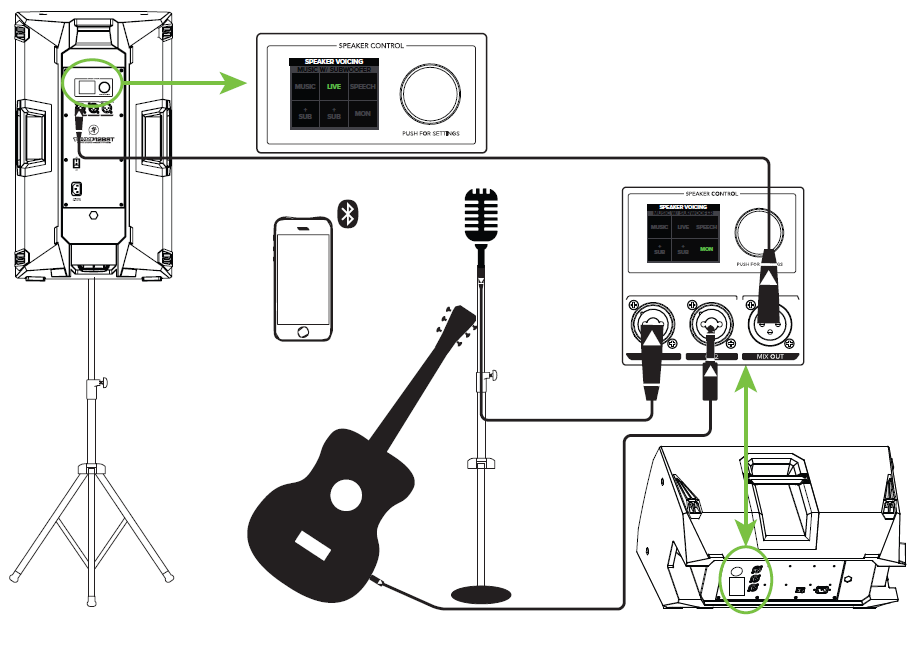
Thump loudspeakers are the perfect tool for singer-songwriters touring the local coffee shops. Bring your favorite axe and mic, Thump loudspeakers and cables, and power cords. In this example, a dynamic microphone is connected to the channel 1 input of a Thump12BST loudspeaker, used for monitoring purposes. Now, grab your axe and plug it directly into the channel 2 input. Or if you use effects, connect the guitar to the effects input and another cable from the effects output to the channel 2 input. Another Thump12BST loudspeaker will be used for the main PA. Simply connect a cable from the Thump12BST monitor’s MIX OUT jack to the Thump12BST PA’s channel 1 input. The last thing to connect is your device… via Bluetooth! With this, you can play backing tracks and/or programmed drum beats to accompany your brilliant performance to the adoring crowd! The Bluetooth audio will stream to the monitor speaker and is linked to the main via the XLR connection. Do not wirelessly link the loudspeakers or you will get redundant audio from the Bluetooth source! For the output, you will want to set a speaker mode, described in detail on page 14. For this type of setup, Live works well for the main Thump12BST. However, don’t count out the Music mode! Select the Monitor mode for the Thump12BST monitor.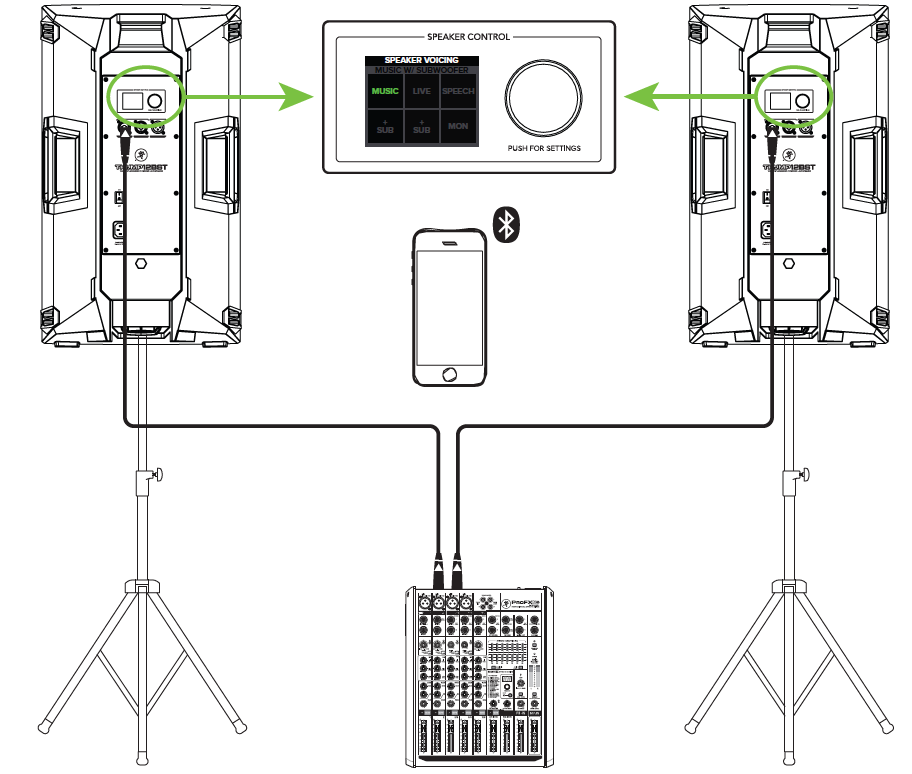
In this example, a ProFX8v2 mixer is connected directly to two Thump12BST loudspeakers. It is the perfect setup for a small club or… a fun karaoke house party! Simply connect the L/R outputs of the ProFX8v2 mixer to the CH1 input of each Thump12BST loudspeaker. For karaoke, you could play tunes through the device (connected via Bluetooth) with mics plugged directly into the inputs (or mixer first). Many options! Don’t forget to wirelessly link the speakers for stereo audio playback from the device and set the Speaker Mode on both loudspeakers to Music!
If you desire a little more boom, add a Thump18S subwoofer to the mix. Here, the L/R outputs of a ProFX8v2 mixer are connected directly to the CH1 inputs of each Thump12BST loudspeaker. Then the Mix Out of each loudspeaker is connected to the channel A and B inputs of a single Thump18S subwoofer. Don’t forget to set the Speaker Modes to Music + Sub.
Small Club System
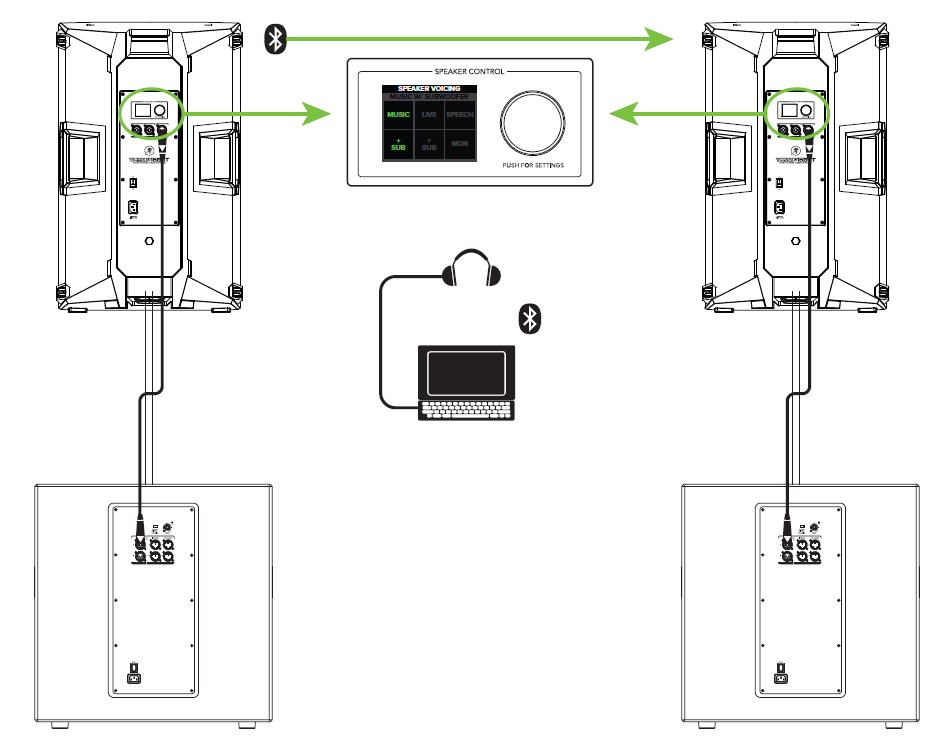
Perhaps you’re a DJ playing bumpin’ tunes in the middle of the night to a crowd that’s groovin’ and dancin’ to your fine selection. In this example, a laptop is connected to the Bluetooth channel of a Thump15BST loudspeaker, which in turn, is linked to another Thump15BST loudspeaker. The Mix Out of each loudspeaker is connected to the channel A input of each Thump18S subwoofer, and a set of headphones is connected to the phone jack of the laptop. The Speaker Modes of both loudspeakers may be set to Music + Sub. Would you look at that! Minimal cable spaghetti and up to 300 feet of Bluetooth connectivity. A winning combination!
DJ System
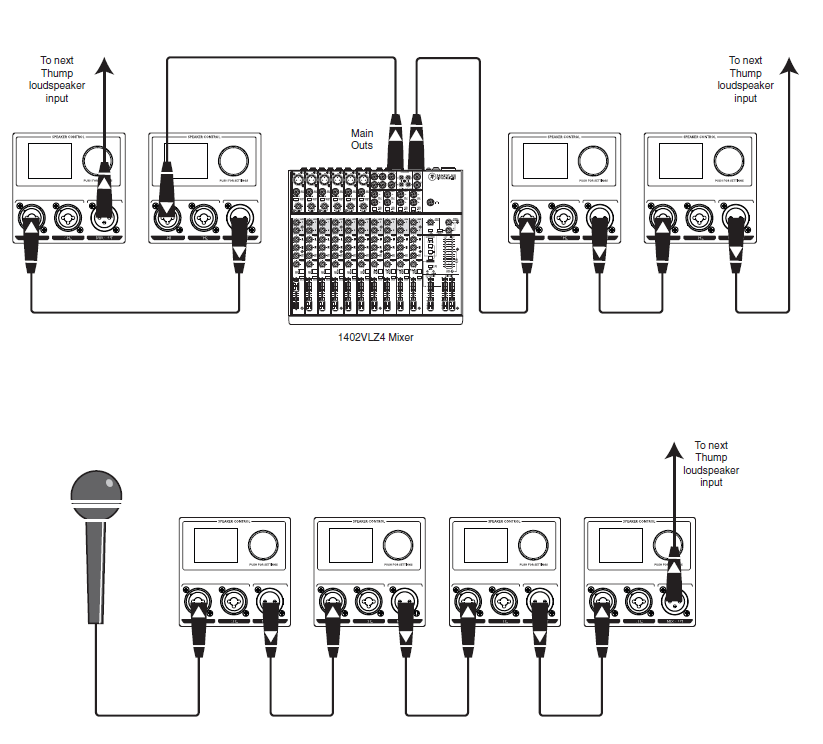
Thump loudspeakers may be daisy-chained via the male XLR connector labeled “MIX OUT”. Simply plug the signal source (i.e., mixer output or microphone) into the input jack(s), and patch that loudspeaker’s mix out jack to the next loudspeaker’s input jack, and so on, daisy-chaining multiple Thump loudspeakers. See above for visual representations of daisy-chaining.
Daisy-Chaining Multiple Thump Loudspeakers
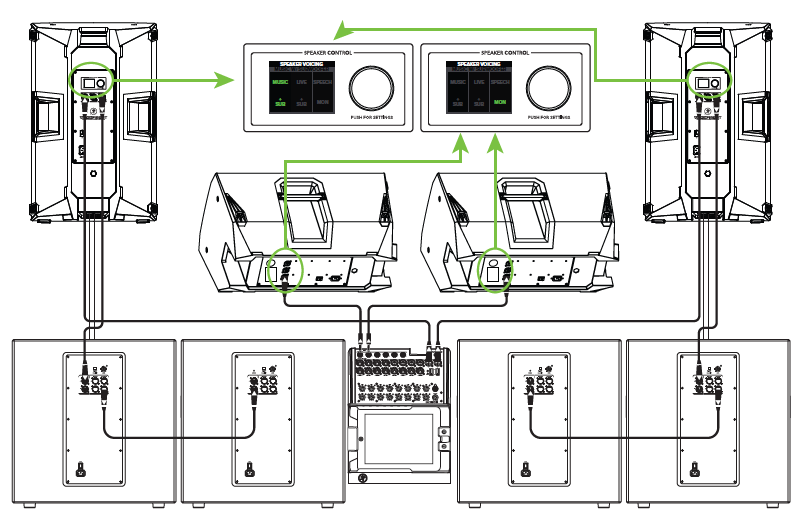
Here’s how to set up a large club system. In this example, the L/R outputs of a DL1608 mixer are connected directly to the CH1 inputs of a pair of Thump15BST loudspeakers. The Speaker Modes of these PA loudspeakers may be set to Music + Sub. The Mix Out of each loudspeaker is then connected to the channel A input of a pair of Thump18S subwoofers. From here, the channel A full-range outputs of the two outer Thump18S subwoofers are connected directly to the channel A inputs of another set of Thump18S subwoofers. Talk about beefy low end! The aux 1 and aux 2 sends from the mixer are connected directly to the CH1 inputs of a pair of Thump12BST loudspeakers to be used as monitors for the band. The Speaker Modes of the monitor loudspeakers may be set to Monitor. There is no device shown in this hookup diagram, but it is entirely possible to connect one… after all, there is still a Bluetooth channel! It would be good for playback music during band breaks and set changeovers. The possibilities are endless!
Large Club System
Protection Circuitry
Thump loudspeakers employ a built-in limiter for less distortion at peak levels. A dynamic bass response circuit provides optimal low-frequency response regardless of overall output level. Additional protection includes an automatic thermal shutdown should the amp overheat. However, with Class-D amp technology, which is highly efficient, this should never be a problem. The protection circuits are designed to protect the loudspeakers under reasonable and sensible conditions. Should you choose to ignore the warning signs [e.g., excessive distortion], you can still damage the speaker in the loudspeaker by overdriving it past the point of amplifier clipping. Such damage is beyond the scope of the warranty.
Limiting
The driver has its own compression circuit, which helps protect it from damaging transient peaks. The compressor is designed to be transparent and is not noticeable under normal operating conditions.
Overexcursion Protection
A subsonic filter circuit just prior to the power amplifier prevents ultra-low frequencies from being amplified. Excessive low-frequency energy can damage the woofer by causing it to “bottom out,” also known as overexcursion, which is equivalent to a mechanical form of clipping.
Thermal Protection
All amplifiers produce heat. Thump loudspeakers are designed to be efficient both electrically and thermally. In the unlikely event of the amplifier overheating, a built-in thermal switch will activate, muting the signal. When the amplifier has cooled down to a safe operating temperature, the thermal switch resets itself, and the Thump loudspeaker resumes normal operation. If the thermal switch activates, try turning down the level control a notch or two on the mixing console (or via the Speaker Control knob) to avoid overheating the amplifier. Be aware that direct sunlight and/or hot stage lights may be the culprit of an amplifier overheating.
AC Power
Be sure the Thump loudspeaker is plugged into an outlet that is able to supply the correct voltage specified for your model. It will continue to operate at lower voltages, but will not reach full power. Be sure the electrical service can supply enough amperage for all the components connected to it. We recommend that a stiff (robust) supply of AC power be used because the amplifiers place high current demands on the AC line. The more power that is available on the line, the louder the speakers will play and the more peak output power will be available for a cleaner, punchier bass. A suspected problem of “poor bass performance” is often caused by a weak AC supply to the amplifiers. Never remove the ground pin on the power
cord or any other component of the Thump loudspeaker. This is very dangerous.
Care and Maintenance
Your Thump loudspeakers will provide many years of reliable service if you follow these guidelines:
- Avoid exposing the loudspeakers to moisture. If they are set up outdoors, be sure they are under cover if rain is expected.
- Avoid exposure to extreme cold (below freezing temperatures). If you must operate the loudspeakers in a cold environment, warm up the voice coils slowly by sending a low-level signal through them for about 15 minutes prior to high-power operation.
- Use a dry cloth to clean the cabinets. Only do this when the power is turned off. Avoid getting moisture into any of the openings of the cabinet, particularly where the drivers are located.
Room Acoustics
Thump loudspeakers are designed to sound fantastic in nearly every application. But, room acoustics play a crucial role in the overall performance of a sound system. However, the wide high-frequency dispersion of the Thump loudspeakers helps to minimize the problems that typically arise. Here are some additional placement tips to help overcome some typical room problems that might arise:
- Placing loudspeakers in the corners of a room increases the low-frequency output and can cause the sound to be muddy and indistinct.
- Placing loudspeakers against a wall increases the low-frequency output, though not as much as corner placement. However, this is a good way to reinforce the low frequencies, if so desired.
- Avoid placing the speakers directly on a hollow stage floor. A hollow stage can resonate at certain frequencies, causing peaks and dips in the frequency response of the room. It is better to place them on a sturdy stand designed to handle the weight of the loudspeaker.
- Position the loudspeakers so the high-frequency drivers are two to four feet above ear level for the audience (making allowances for an audience that may be standing/dancing in the aisles). High frequencies are highly directional and tend to be absorbed much more easily than lower frequencies. By providing direct line-of-sight from the loudspeakers to the audience, you increase the overall brightness and intelligibility of the sound system.
Troubleshooting
No power
- Our favorite question: Is it plugged in? Make sure the AC outlet is live [check with a tester or lamp].
- Our next favorite question: Is the power switch on? If not, try turning it on.
- Make sure the line cord is securely seated in the line cord socket and plugged all the way into the AC outlet.
- Is the power LED on the front panel illuminated? If not, make sure the AC outlet is live. If so, refer to “No sound” below.
- The internal AC line fuse may be blown. This is not a user-serviceable part. If you suspect the AC line fuse is blown, please see the “Repair” section next.
No sound
- Is the level knob for the input source turned down? Verify that all the volume controls in the system are properly adjusted. Look at the level meter to ensure that the mixer is receiving a signal.
- Is the signal source working? Make sure the connecting cables are in good repair and securely connected at both ends. Make sure the output level control on the mixing console is turned up sufficiently to drive the inputs of the speaker.
- Make sure the mixer does not have a mute on or a processor loop engaged. If you find something like this, make sure the level is turned down before disengaging the offending switch
- Has it shut down? Make sure there is at least six inches of free space behind each Thump loudspeaker.
Poor sound
- Is it loud and distorted? Make sure that you’re not overdriving a stage in the signal chain. Verify that all level controls are set properly.
- Is the input connector plugged completely into the jack? Be sure all connections are secure.
Noise
- Make sure all connections to the active loudspeakers are good and sound.
- Make sure none of the signal cables are routed near AC cables, power transformers, or other EMI-inducing devices.
- Is there a light dimmer or other SCR-based device on the same AC circuit as the Thump loudspeaker? Use an AC line filter or plug the loudspeaker into a different AC circuit.
Hum
- Try disconnecting the cable connected to the input jack. If the noise disappears, it could be a “ground loop,” rather than a problem with the Thump loudspeaker. Try some of the following troubleshooting ideas:
- Use balanced connections throughout your system for the best noise rejection.
- Whenever possible, plug all the audio equipment’s line cords into outlets that share a common ground. The distance between the outlets and the common ground should be as short as possible.
Bluetooth Issues
- Please email or call Technical Support if you are having Bluetooth connection issues:
- mackie.com/support-contact
- 1-800-898-3211
For more manuals by Mackie, visit ManualsLibraryy
Mackie Thump 12BST 1300W Active PA Speakers-FAQs
Are Mackie Thump speakers any good?
Yes, Mackie Thump speakers are known for their clear, punchy sound and reliable performance, making them ideal for live music, DJs, and public speaking events.
Is Mackie an American company?
Yes, Mackie is an American brand, founded in Seattle in 1988. It is a part of LOUD Technologies, specializing in professional audio equipment.
Are Mackie Thump speakers waterproof?
No, Mackie Thump speakers do not have an IP rating and are not water or moisture resistant, so they should not be used in wet or damp environments.
Can a Mackie mixer power passive speakers?
Yes, Mackie PPM series mixers can power both active and passive speakers, making them versatile for various audio setups.
Does the Mackie Thump 212 have Bluetooth?
Yes, the Thump212XT model features Bluetooth connectivity, allowing you to stream audio wirelessly and link two speakers in Stereo or Dual Zone mode using the Thump Connect 2 app.
Does the Mackie Thump series support Bluetooth audio?
Yes, models like Thump GO and ThumpXT offer Bluetooth® streaming from your phone, with options to connect two speakers simultaneously for stereo playback.
What is the Mackie Thump 212 active speaker?
The Mackie Thump 212 is a 1400W 12-inch active loudspeaker with built-in features like Feedback Eliminator and Music Ducking. It’s lightweight, durable, and ideal for mobile PA setups, DJs, and live events.
How much power does a Mackie Thump 212 use?
The Thump 212 features a 2-channel 1400-watt amplifier, powering a 12″ woofer and a 1″ compression driver, delivering powerful and clear audio output.

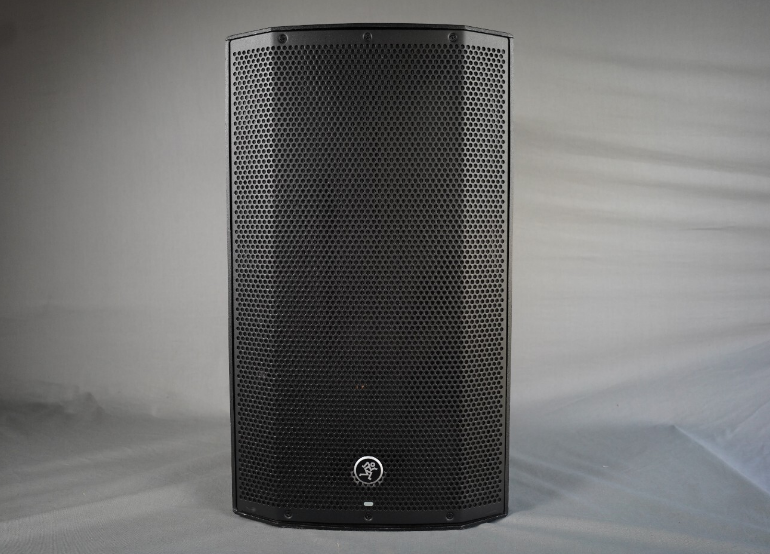
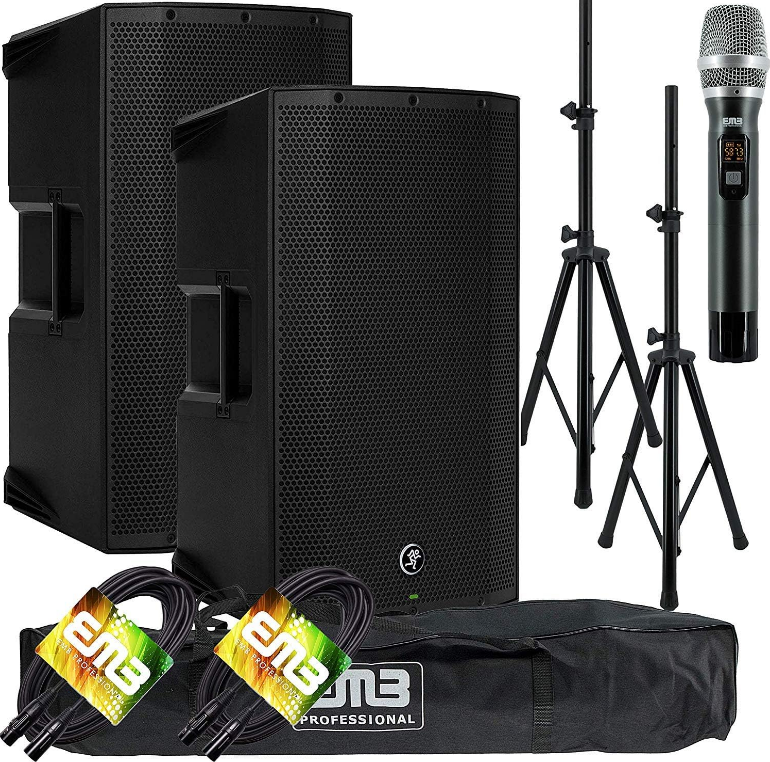 Important Safety Instructions
Important Safety Instructions